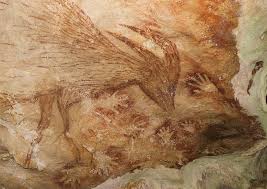New Delhi: Archaeologists have discovered the world’s oldest known cave art — a life-sized picture of a wild pig that was painted at least 45,500 years ago in Indonesia.
The cave painting uncovered in South Sulawesi consists of a figurative depiction of a warty pig, a wild boar that is endemic to this Indonesian island.
The finding, published Wednesday in the journal Science Advances, also represents some of the earliest archaeological evidence for modern humans in the region.
“The Sulawesi warty pig painting we found in the limestone cave of Leang Tedongnge is now the earliest known representational work of art in the world, as far as we are aware,” said Professor Adam Brumm from Griffith University in Australia.
“The cave is in a valley that is enclosed by steep limestone cliffs, and is only accessible by a narrow cave passage in the dry season, as the valley floor is completely flooded in the wet season,” said Brumm.
He noted that the isolated Bugis community living in this hidden valley claim it had never before been visited by Westerners.
The researchers noted that the Sulawesi warty pig painting, dated to at least 45,500 years ago, is part of a rock art panel located above a high ledge along the rear wall of Leang Tedongnge.
“It shows a pig with a short crest of upright hairs and a pair of horn-like facial warts in front of the eyes, a characteristic feature of adult male Sulawesi warty pigs,” Brumm said.
“Painted using red ochre pigment, the pig appears to be observing a fight or social interaction between two other warty pigs, he added.
The previously oldest dated rock art ‘scene’ at least 43,900 years old, was a depiction of hybrid human-animal beings hunting Sulawesi warty pigs and dwarf bovids.
It was discovered by the same research team at a nearby limestone cave site.
Basran Burhan, an Indonesian archaeologist and Griffith University PhD student, who led the survey, said that humans have hunted Sulawesi warty pigs for tens of thousands of years.
“These pigs were the most commonly portrayed animal in the ice age rock art of the island, suggesting they have long been valued both as food and a focus of creative thinking and artistic expression,” Burhan added.
The team sampled the art for Uranium-series dating, a technique to determine the age of calcium carbonate materials.
“Rock art produced in limestone caves can sometimes be dated using Uranium-series analysis of calcium carbonate deposits (‘cave popcorn’) that form naturally on the cave wall surface used as a ‘canvas’ for the art,” said Professor Maxime Auburt from Griffth University.
It was this mineral deposit that, after careful removal by Aubert, yielded an age of 45,500 years, indicating that the rock art scene had been painted sometime prior to this.
A second Sulawesi warty pig image, from Leang Balangajia, another cave in the region, was dated to at least 32,000 years ago.
The scientists have now dated multiple examples of early rock art in Sulawesi, including depictions of animals and narrative scenes that are outstanding both for the quality of their execution and rarity worldwide.
“We have found and documented many rock art images in Sulawesi that still await scientific dating,” said study co-author Adhi Agus Oktaviana, a researcher from Indonesia’s leading archaeological research centre ARKENAS.
“We expect the early rock art of this island to yield even more significant discoveries, Oktaviana added.
